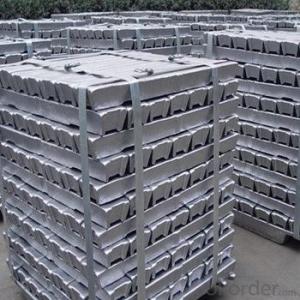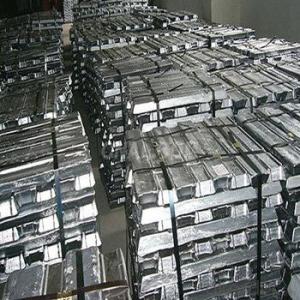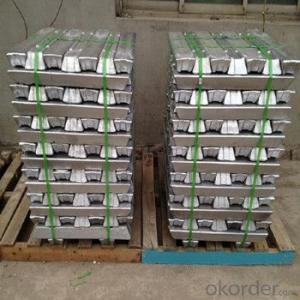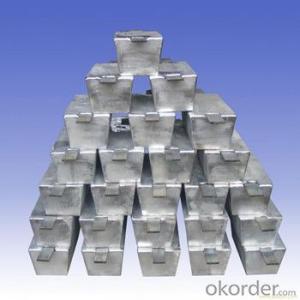Aluminum Pig/Ingot Provide From Factories
- Loading Port:
- China main port
- Payment Terms:
- TT OR LC
- Min Order Qty:
- 1000 m.t.
- Supply Capability:
- 100000 m.t./month
OKorder Service Pledge
OKorder Financial Service
You Might Also Like
Pure Aluminum Pig/Ingot Used for Industry
1.Structure of Aluminum Pig/Ingot
A material that has been cast into a shape in order to be transported and processed easier than in an unprocessed form. An ingot is typically rectangular in shape, which allows it to be stacked. Ingots are most commonly associated with metals, with ingots of gold held in the vaults of banks and brokerages being popular images.
Aluminum Ingot is with the AL as the main chemical composition.Aluminum Ingot is used for industry,such as automobile,pinning and weaving,electron broadly and so on. Aluminum Ingot has the following advantages: easy control and operation, fast melting.
2.Main Features of the Aluminum Pig/Ingot
•High Purity
•Easy control and operation
•High strength
•Fast melting
•Competitive price
•Best Service
3.Aluminum Pig/Ingot Images


4.Aluminum Pig/Ingot Specification
Grade | Chemical Composition % | |||||||||
Al≥ | impurities ≤ | |||||||||
Si | Fe | Cu | Ga | Mg | Zn | Mn | others | Sum | ||
Al99.9 | 99.90 | 0.50 | 0.07 | 0.005 | 0.02 | 0.01 | 0.025 | - | 0.010 | 0.10 |
Al99.85 | 99.85 | 0.80 | 0.12 | 0.005 | 0.03 | 0.02 | 0.030 | - | 0.015 | 0.15 |
Al99.7 | 99.70 | 0.10 | 0.20 | 0.010 | 0.03 | 0.02 | 0.030 | - | 0.030 | 0.30 |
Al99.6 | 99.60 | 0.16 | 0.25 | 0.010 | 0.03 | 0.03 | 0.030 | - | 0.030 | 0.40 |
Al99.5 | 99.50 | 0.22 | 0.30 | 0.020 | 0.03 | 0.05 | 0.050 | - | 0.030 | 0.50 |
Al99.00 | 99.00 | 0.42 | 0.50 | 0.020 | 0.03 | 0.05 | 0.050 | - | 0.050 | 1.00 |
5.FAQ of Aluminum Pig/Ingot
We have organized several common questions for our clients,may help you sincerely:
①How about your company?
A professional factory which foucs on producing the aluminum pig,can meet customers' requiement to the quality and grade.The quality also have been accepted by customer.Already got the good reputation among the customers.It have gotten lot of much experience.The facrtory has the professional Technical Worker and the advanced equipments for production.Beside,it has the profesional teams to operate the whole proess for exporting.OEM service is availble and welcome.The items have beedn exported around the world,and have been acceptable among the customers,and have gotten the good reputation already.No matter from the quality,price and service,can be guaranteed for the cusgtomers.High purity and diffent grade are available.
②How to guarantee the quality of the products?
We have established the international advanced quality management system,every link from raw material to final product we have strict quality test;We resolutely put an end to unqualified products flowing into the market. At the same time, we will provide necessary follow-up service assurance.
③How long can we receive the prod rking days, We will arrange the factory delivery as soon as possible. The pecific time of receiving is related to the state and position of customers.Commonly 7 to 10 working days can be served.
- Q:How can the recycling infrastructure for aluminum ingots be improved?
- One way to improve the recycling infrastructure for aluminum ingots is by implementing more efficient collection and sorting systems. This can involve setting up dedicated recycling centers that accept aluminum scrap from various sources, such as households, industries, and construction sites. Additionally, improving the technology used for sorting and separating different types of aluminum scrap can enhance the quality and purity of the ingots produced. Furthermore, increasing awareness and education about the importance of recycling aluminum can encourage more individuals and businesses to participate, leading to a larger supply of scrap for recycling.
- Q:What are the different finishing processes for aluminum ingots?
- Aluminum ingots can be subjected to various finishing processes to enhance their appearance, durability, and suitability for specific applications. Among these processes is anodizing, where the ingots are immersed in an electrolytic solution and an electrical current is passed through them. This generates an oxide layer on the surface of the ingot, which can be dyed to achieve different colors. Anodizing not only improves the ingot's aesthetics but also enhances its resistance to corrosion and durability. Another finishing process is powder coating, wherein a dry powder is electrostatically applied to the ingot's surface and then cured under heat to form a protective and decorative coating. Powder coating exhibits exceptional resistance to corrosion, chemicals, and UV rays, making it ideal for outdoor applications. Polishing is yet another technique employed on aluminum ingots, involving the mechanical rubbing of the ingot's surface with abrasive materials to create a smooth and shiny finish. This process effectively eliminates surface imperfections and scratches, resulting in a high-quality appearance. Painting is a widely used finishing process for aluminum ingots, entailing the application of a liquid paint coating onto the ingot's surface. Painting not only enhances the appearance but also provides protection against corrosion and environmental factors. Moreover, there exist other finishing techniques such as brushing, buffing, and sandblasting, which are utilized to achieve diverse surface textures and finishes on aluminum ingots. Ultimately, the choice of finishing process for aluminum ingots relies on the desired appearance, functionality, and intended application of the final product. Each finishing process possesses its own advantages and can be customized to fulfill specific requirements.
- Q:How is aluminum ingot produced?
- Aluminum ingot is produced through a process known as smelting. The first step in this process involves the extraction of bauxite, which is a mineral rich in aluminum oxide. Bauxite is mined from open-pit mines and then refined to remove impurities. Once the refined bauxite is obtained, it is then converted into alumina through a chemical process called the Bayer process. In this process, the bauxite is dissolved in a solution and heated under pressure, resulting in the formation of alumina. The alumina is then transported to smelting facilities where it is further processed to produce aluminum ingots. The smelting process involves the use of electrolysis, where the alumina is dissolved in a molten cryolite bath and subjected to an electric current. This causes the aluminum ions to be attracted to the cathode, where they collect and solidify into ingots. After solidification, the ingots are removed from the electrolytic cell and further processed to meet specific requirements. They are typically cast into large blocks or rectangular shapes to facilitate storage and transportation. Overall, the production of aluminum ingots involves a series of complex processes starting from the extraction of bauxite to the smelting and casting of aluminum. These ingots then serve as the raw material for various industries that utilize aluminum in the production of a wide range of products.
- Q:How is the purity of aluminum ingots determined?
- The purity of aluminum ingots is determined through various analytical techniques and testing methods. One common method used is spectroscopy, specifically inductively coupled plasma optical emission spectroscopy (ICP-OES) or inductively coupled plasma mass spectrometry (ICP-MS). These techniques are capable of analyzing the elemental composition of the aluminum ingot, including the presence of impurities such as iron, silicon, copper, zinc, and others. Another technique employed is atomic absorption spectroscopy (AAS), which focuses on measuring the concentration of specific elements in the aluminum ingot. This method allows for the detection of trace impurities, as it is highly sensitive and selective for individual elements. Chemical analysis is also utilized to determine the purity of aluminum ingots. Acid digestion methods, such as dissolution in nitric acid or hydrochloric acid, are commonly used to dissolve the ingot and create a solution that can be analyzed for impurities. The resulting solution is then subjected to various tests, including titration, colorimetry, or gravimetric analysis, to quantify the impurities present. In addition to these techniques, physical testing methods can be employed to evaluate the purity of aluminum ingots. These methods involve measuring the physical properties of the ingot, such as density, melting point, or electrical conductivity. Deviations from the expected values can indicate the presence of impurities. Overall, determining the purity of aluminum ingots involves a combination of spectroscopic, chemical, and physical analysis techniques, allowing for a comprehensive assessment of the elemental composition and impurity levels in the ingot sample.
- Q:How many tons of alumina for a ton of aluminum ingot, alumina and electrolytic aluminum what is the difference?
- 1.889 tons of alumina contains a ton of metal aluminum. Or 1.889 tons of alumina can theoretically extract 1 tons of pure aluminum.
- Q:What are the common uses of aluminum ingots?
- Due to their unique properties, aluminum ingots find a wide range of common uses. One industry that heavily relies on aluminum ingots is the automotive industry, where they are utilized in the manufacturing of various products. Engine components like cylinder heads and engine blocks, as well as body panels and wheels, are made from aluminum ingots. This is because the lightweight nature of aluminum helps improve fuel efficiency and reduce vehicle weight. The construction industry also benefits from the use of aluminum ingots. It is used to fabricate window frames, door frames, roofing materials, and structural elements. Aluminum's high resistance to corrosion makes it suitable for outdoor applications, and its lightweight nature allows for easy installation and transportation. In the packaging industry, aluminum ingots play a vital role. They are used to make cans for beverages and food items because of their excellent barrier properties, which protect the contents from light, moisture, and air. Additionally, aluminum cans are easily recyclable, making them a sustainable choice. The electrical industry also heavily relies on aluminum ingots. They are utilized in the production of power transmission lines, electrical wiring, and conductors. Aluminum's high electrical conductivity and low weight make it an ideal material for conducting electricity efficiently and cost-effectively. Lastly, the aerospace industry benefits from the use of aluminum ingots. The lightweight yet strong characteristics of aluminum make it an excellent choice for manufacturing aircraft components such as wings, fuselages, and structural parts. The weight reduction achieved with aluminum significantly improves fuel efficiency and overall performance. In conclusion, aluminum ingots have diverse applications in various industries, including automotive, construction, packaging, electrical, and aerospace. Its versatility, strength, and lightweight nature make it an essential material in modern manufacturing processes.
- Q:How can I extract aluminium ingots from cans?
- If you want to sell, small and medium-sized aluminum factory will generally buy, but if you do not remove other components, and direct sell cans on the price is not much difference. When you first start, you certainly have little experience. When you have industry experience, consider whether you want to expand or not, and most importantly, how much you know about the industry.
- Q:How much does it cost to process the aluminum ingots into T5-6063 models? Now, what about costing the aluminum ingot or the aluminum bar?
- T6 is artificially aged by solid solution heat treatmentIt is suitable for the products which are treated by solid solution heat treatment, no longer cold processing (can be straightened and leveling, but does not affect the mechanical performance limit)
- Q:What are the energy requirements for producing aluminum ingots?
- The energy requirements for producing aluminum ingots can vary depending on several factors such as the type of production process, the source of energy used, and the efficiency of the production facility. However, generally, the production of aluminum ingots is an energy-intensive process. The primary method for producing aluminum ingots is through the smelting of aluminum oxide, or alumina, which is obtained from bauxite ore. The most common method used is the Hall-Héroult process, which involves the electrolysis of alumina dissolved in a molten cryolite electrolyte. In this process, a significant amount of energy is required to heat the alumina to its melting point of around 2,040 degrees Celsius and maintain it at this temperature. The energy is typically provided by large electric currents passed through the molten electrolyte, where the electrolysis takes place. Additionally, the production of aluminum ingots requires a substantial amount of electrical energy to break the chemical bonds in the alumina and separate the aluminum metal from the oxygen. The electrolysis process consumes a substantial amount of electricity, making aluminum production one of the largest consumers of electrical energy worldwide. The energy requirements for producing aluminum ingots can also be influenced by the source of electricity used. If renewable energy sources such as hydropower, wind power, or solar power are utilized, the environmental impact and carbon footprint of aluminum production can be significantly reduced. On the other hand, if the electricity is generated from non-renewable sources such as coal or natural gas, the energy requirements may be higher and contribute to higher greenhouse gas emissions. Efficiency improvements and technological advancements have been made in aluminum production processes over the years, leading to reductions in energy consumption. For example, the development of pre-baked anode technology has increased the energy efficiency of the Hall-Héroult process. Furthermore, recycling aluminum requires significantly less energy compared to primary production from bauxite ore, making it a more sustainable and energy-efficient option. In conclusion, the energy requirements for producing aluminum ingots are substantial due to the high temperatures required for the smelting process and the electricity needed for electrolysis. However, advancements in technology and the utilization of renewable energy sources can help reduce the energy consumption and environmental impact of aluminum production.
- Q:How are aluminum ingots used in the production of electrical enclosures?
- Aluminum ingots are used in the production of electrical enclosures as they are melted down and cast into specific shapes and sizes to create the main body of the enclosure. The ingots provide the necessary raw material for the enclosure's construction, offering strength, durability, and corrosion resistance. Additionally, aluminum ingots can be easily formed, machined, and welded, allowing for the creation of intricate designs and precise dimensions required for electrical enclosures.
1. Manufacturer Overview |
|
|---|---|
| Location | |
| Year Established | |
| Annual Output Value | |
| Main Markets | |
| Company Certifications | |
2. Manufacturer Certificates |
|
|---|---|
| a) Certification Name | |
| Range | |
| Reference | |
| Validity Period | |
3. Manufacturer Capability |
|
|---|---|
| a)Trade Capacity | |
| Nearest Port | |
| Export Percentage | |
| No.of Employees in Trade Department | |
| Language Spoken: | |
| b)Factory Information | |
| Factory Size: | |
| No. of Production Lines | |
| Contract Manufacturing | |
| Product Price Range | |
Send your message to us
Aluminum Pig/Ingot Provide From Factories
- Loading Port:
- China main port
- Payment Terms:
- TT OR LC
- Min Order Qty:
- 1000 m.t.
- Supply Capability:
- 100000 m.t./month
OKorder Service Pledge
OKorder Financial Service
Similar products
New products
Hot products



























